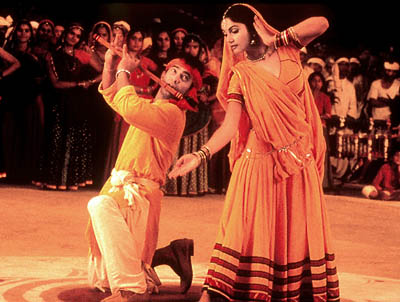Lagaan as allegory
This weekend I watched the classic Bollywood film "Lagaan" for the first time since I went to India. It tells the story of a group of villagers during the time of the British Raj. Humiliated and bullied by their Imperial overlords, they are challenged by the Cantonment commander to a game of cricket: a game they have never seen before. If they do not accept the bet, they have to pay double an already crippling tax. Win and they avoid all tax for three years. Fail and they have to pay triple tax. The story progresses with traitors, unexpected helpers, unexpected heroes and some of the best Bollywood tunes ever (http://www.youtube.com/watch?v=Q432KIiwX-Q) until we reach the conclusion of a cricket match every bit as tense and exciting as Edgbaston 2005.

But it is anything but classic Bollywood fodder, thanks to its production and themes. It was seen as one of Bollywood's first films to successfully cross-over to the non-ethnic market, received an Academy Award Nomination and made it into the UK Top 10 following its commercial release.
The film is by far my favourite Indian film, largely because the character of Guran is pretty much an Indian Brian Blessed,
but also because it gives some interesting insights into Indian culture, opinion, prejudice and thought. Firstly, there is the central importance of cricket, itself. The film really gets across the tensions and intrigues of cricket that allows it to be continuously dissected and analysed by the Indian media and commentators. But it also shows the personal enmity, camaraderie which makes the sport as exciting as any Indian soap opera.
Secondly, it shows India's complex relationship with its Colonial past. There is the cruel commander of the Cantonment who humiliates his subjects, showers them with contempt and uses subterfuge in the contest. Then there is the kindly sister of the commander who teaches the villagers how to play, learns the language and customs of the natives and falls in love with an Indian. And finally there are the cricket umpires guided only by the rules of the game and a sense of fair play, backed up by Imperial commanders disappointed in the behaviour of their underling and who delight in the puck and effort of the villagers. These are metaphors for how Indians view their formal colonial masters today: oppressive pillagers who were in it for their own good; strict law-makers who keep society running straight; and kindly masters who taught and educated their citizens. Indians both love and hate their former imperial rulers and this film illustrates that well.
As with all Bollywood films, the hero, Bhuvan, is a good Hindu boy who knows the stories of the Gods and loves his mother over everything else. The irony being that the actor who plays Bhuvan is Aamir Khan, a Muslim. In this film, Muslims play side-by-side with their Hindu brothers, contributing fully to the team. But the man who betrays the team, and who is eventually redeemed, is a Muslim which sadly reflects the mistrust some Hindu Indians hold towards their Muslim countrymen.
The film pointedly spends time focusing on the flight of Untouchables in caste-ridden rural India. One man short of a full Eleven, Bhuvan recruits the Untouchable Kachra to the team because of his ability to leg-spin the ball with his crippled hand. The other members refuse to play with an Untouchable for fear of polluting the caste system. Bhuvan chastises the villagers for their prejudice and touches Kachra: a significant act in India's conservative villages where low-caste Untouchables are still regularly treated as sub-human and killed today. Kachra turns into a hero of the piece, taking a hat-trick to collapse the British middle-order and avoiding getting out to some vicious bowling from the British "hard man" to allow the villagers to win.
Overall it's a brilliant, fun film with all the essentials of a good movie: Fighting oppressive aristocrats in echo of Braveheart; A rousing, winning speech (or song) on the eve of battle familiar to watchers of Shakespeare; Period dress to rival Pride and Prejudice; Improvised training that would look good in Rocky 4; And a sneering baddy that would make Shrek's Prince Charming look a winner! But what makes this film stand out is the quality of production and storytelling combined with challenging some of India's most damaging habits, through questioning the caste system and showing the solidarity of Muslims with Hindus. It takes the best of Indian epic cinema and elevates it for an international audience.


